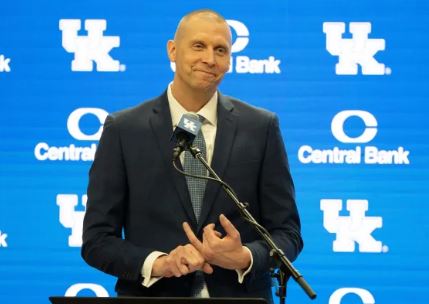Ansley Almonor, a forward for Fairleigh Dickinson, committed to Kentucky on Thursday morning, making 11 scholarship players on Mark Pope’s inaugural UK squad. Almonor is a 6’7″, 219-pound forward with a career 3-point shooting percentage of 38.5 percent. Pope, a future senior from Spring Valley, next York, should be the best choice for the next UK coach if he wants to use a “small ball” 4 man.
In light of the bigger picture, Pope stated in a podcast interview with Jon Rothstein of CBS Sports this week that he hopes to have the first Wildcats lineup he coaches consist of 13 scholarship players, which is the NCAA maximum for men’s basketball. It makes sense to question if a head coach can keep a 13-man squad motivated and pleased in these impatient times. Pope, however, would rank among the coaches most suited to make effective use of a huge roster based on his historical performance.
Pope shares UK college coach Rick Pitino’s belief in benching players. Think about this: During the previous two seasons that he led BYU, Pope did not have a single player who played an average of 30 minutes each game. ▪ Pope used a 10-man rotation in each of the previous two seasons. The ten BYU rotation players saw between 10.2 and 29 minutes of action each game on average in 2022–2023. The top 10 Cougars players’ average playing time during the previous campaign ranged from 10 to 27 minutes.
Visit Kentucky.com/Sports/SPT-Columns-Blogs/Mark-Story/article288509942.html#storylink=cpy to learn more.
▪ In his five years as BYU’s coach, Pope only had four players who played 30 minutes or more per game on average (guard Alex Barcello was one of those players who did it three times). ▪ Pope’s normal playing rotations at Brigham Young University were eight players (2019–20), ten (2020–21), nine (2021–22), ten (2022-23), and ten (this past season) over his five seasons (2019–2024). If Pope uses his team’s players the same way at Kentucky as he did at BYU, UK men’s basketball will be departing rather sharply from the standard operating procedures of the John Calipari era.
Calipari at UK favored a tight playing rotation, with two major exceptions: the two-platoon system in 2014–15 and the 10-deep replacement pattern this past season. In contrast to Pope, who had just four players at BYU who averaged more than 30 minutes per game, Calipari had 13 guys at Kentucky who did the same in his five seasons. Six players on Calipari’s inaugural Final Four squad at UK in 2010–11 played in all 38 games, with Josh Harrellson and Brandon Knight averaging 28.5 and 35.9 minutes per game, respectively.
Six of the seven players on Kentucky’s 2011–12 NCAA championship squad saw action in all 40 games as part of a rotation. Between 26.1 (Darius Miller) and 32.6 (Marquis Teague) minutes per game, on average, were the six top scorers. The top four players on the UK’s 2016–17 Elite Eight roster, Malik Monk (32.1), Isaiah Briscoe (30.1), Bam Adebayo (30.1), and De’Aaron Fox (29.6), each played about thirty minutes per game in a seven-man rotation. The best players in Kentucky’s seven-man rotation during Oscar Tshiebwe’s national player of the year campaign (2021–2022) all averaged between 17 and 32 minutes per game.
As far as roster construction goes, it seems like Kentucky and Calipari are taking quite different routes. Now that he is Arkansas’s head coach, Calipari seems to be looking to focus more on his tiny rosters. In a recent interview with Craig Robinson, the former coach of Oregon State, for the podcast “Ways to Win,” Calipari stated that going forward, he only wants “eight or nine” scholarship players on his teams. Citing the high rate of player transfers in the present day, Calipari stated he could not see the need to teach developmental players as you would effectively be preparing them for their next school.
Pope and Kentucky seem to be making completely opposite bets. If Kentucky adopts a 10-player rotation, it could create more opportunities for players who aren’t yet ready to be one-and-done pros to secure significant reserve roles early in their careers, rather than just sitting on the bench while the stars play over 30 minutes each game. The key question is whether under Pope, players like Charles Matthews or Bryce Hopkins—who played limited minutes as freshmen under Calipari before becoming standout players after transferring to Michigan and Providence, respectively—would get enough meaningful playing time in large rotations early in their Kentucky careers to feel comfortable staying and developing at UK over multiple years.

